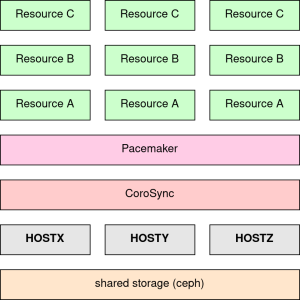Configuration
The inventory may define these hosts:
observers: Set of hosts to observe the cluster (only the first is considering)Hypervisors: Set of machines to hosts VMs.
Remember that the cluster must contains an odd number of machines. For example three hypervisors or one observer and two hypervisors.
Node redundancy
All nodes in the cluster have an access to a shared storage via ceph (see Shared storage section). With it, the cluster is in N to N redundancy mode.
- Corosync will provides messaging and membership services.
- Pacemaker will manage the cluster (synchronize resources between each node).
More details on pacemaker here and corosync here.
Management tool
The vm_manager project is an high-level interface of pacemaker and ceph to manage the VM like a resource. He is installed during the installation step and provides the vm-mgr command.
Sub-command
All sub-commands has -n, --name required option to specify which resource should be used.
add_colocation: Adds a colocation constraints between resourcesclone: Creates a copy of the VMcreate: Generates a new resource from a VMcreate_snapshot: Creates a snapshot of a resourcedisable: Stops and removes the resource on the clusterenable: Adds and starts the resource on the clusterget_metadata: Gets a metadata of a resourcelist: Lists all resourceslist_metadata: Lists all keys of a resourcelist_snapshots: Lists all created snapshotspurge: Deletes all snapshots of a resourceremove: Removes the resourceremove_snapshot: Removes a snapshot of a resourcerollback: Rollbacks to a snapshot for a resourceset_metadata: Sets a metadata of a resourcestart: Start a resourcestatus: Gets the status of a resourcestop: Stops a resource
Resources status
Undefined:Disabled:Failed:Started:Starting:Stopping:Stopped:
